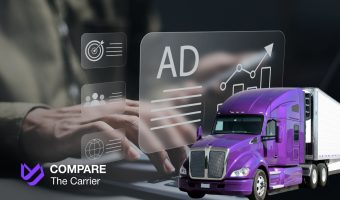How to start an auto transport broker business?
It’s a potentially huge opportunity, tapping into a global market projected near $27 billion as countless vehicles move across the US daily. Getting a piece of that action sounds great, right?
But hold on. If you’re picturing easy money just by making a few calls, let’s pump the brakes. Figuring out exactly how to become an auto transport broker involves navigating a maze of regulations, securing the right auto transport broker licensing, and understanding the nitty-gritty details that separate successful brokers from those who stall out. Is specific auto transport broker training essential? How do you build a network of carriers you can actually trust? Where will your first customers come from?
It’s enough to make anyone’s head spin. That’s why we created this no-nonsense guide. Forget the fluff – we’re diving deep into the practical steps: understanding the market, crafting a solid plan, tackling the legal hurdles, finding the right tools, and building the relationships needed to become a broker who thrives, not just survives. Ready to shift gears from thinking about it to doing it? Let’s map out your route.
The Role and Responsibilities of an Auto Transport Broker
So, you’re exploring the path of starting an auto transport broker business. Great! But what exactly does an auto transport broker do all day? You’re not driving the trucks, and you’re usually not the one needing the car shipped. Think of yourself as the crucial connection point, the logistics whiz who makes the whole process happen smoothly. You’re the matchmaker between people who need cars moved (shippers) and the licensed professionals who move them (carriers).
The Federal Motor Carrier Safety Administration (FMCSA), the folks who regulate trucking, define a broker essentially as someone paid to arrange transportation using authorized motor carriers. Simple definition, but the role involves wearing many hats. If you want to understand how to become an auto transport broker, mastering these responsibilities is step one.
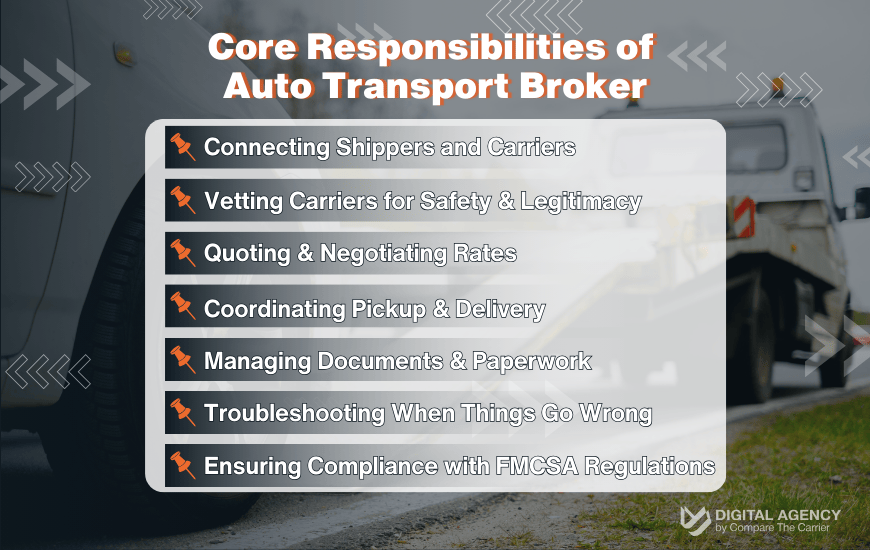
Here’s a breakdown of what’s typically on your plate:
Ultimately, to become a broker is to become a problem-solver, a negotiator, a coordinator, and a trusted advisor in the complex world of vehicle shipping. It’s a dynamic role that’s essential to keeping vehicles moving across the country within the multi-billion dollar auto transport industry.
Researching the Industry and Market
Alright, let’s talk about homework. Before you jump headfirst into starting an auto transport broker business, skipping the research phase is like trying to drive cross-country without a map – you might get there, but it’s going to be messy, expensive, and probably stressful. Doing your due diligence upfront is crucial for setting yourself up for success, it’s important part of the auto transport broker training.
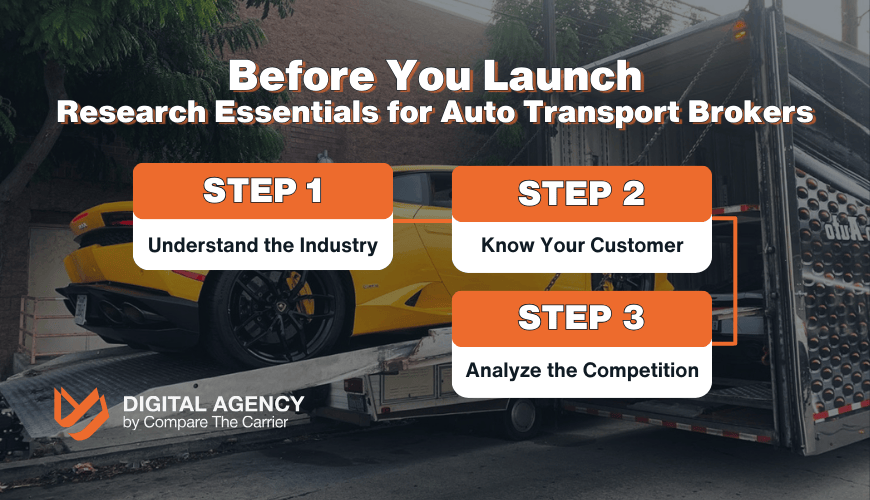
Get the Lay of the Land: Industry Size & Trends
First, understand the playground you’re entering. The US vehicle shipping market is substantial, representing billions in annual activity. Globally, the potential is even bigger, with projections reaching towards $27 billion in the coming years. But it’s not just about size; it’s about trends. Are customers leaning more towards open or enclosed carriers? What routes are busiest? What economic factors are influencing demand?
Know Your Customer: Who Are You Serving?
Who actually needs cars shipped? Hint: It’s a diverse group. Your target audience could include:
You need to figure out who you want to target and understand their specific needs, pain points, and where to find them. What are their demographics? What are their biggest concerns?
Scope Out the Competition: Who Else Is Out There?
Analyze competitors—other brokers, large carriers, digital platforms—to understand their services, pricing, marketing, and potential weaknesses (e.g., service gaps, pricing structure).
Doing this research isn’t just busywork; it directly fuels your business plan, helps you define your unique selling proposition (what makes you different/better?), and shapes your marketing strategy. It’s a critical step on the road to becoming a successful broker.
Navigating the Legal and Licensing Requirements
Alright, let’s talk brass tacks. If the research phase was about mapping your route, this section is about getting your vehicle street legal. Skipping or messing up the legal and licensing requirements when starting an auto transport broker business isn’t just a bad idea – it can stop you cold, lead to hefty fines, or shut you down entirely. Pay close attention here; this is fundamental to how to become an auto transport broker legally and successfully.
Here’s what you absolutely need to handle:
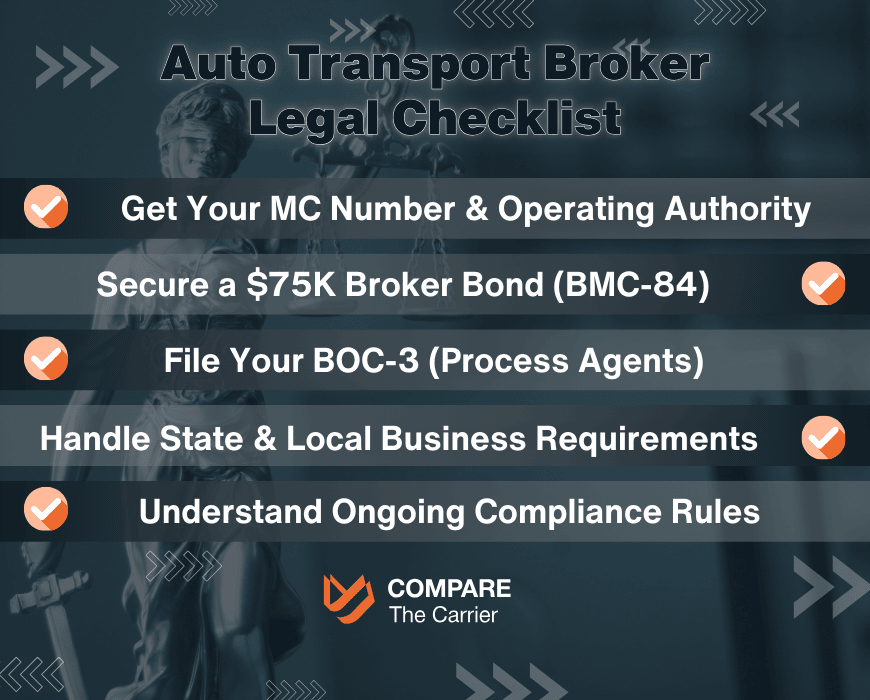
Getting these legal ducks in a row takes time and attention to detail, but it’s the bedrock of a legitimate and sustainable auto transport brokerage.
Setting Up Your Business Infrastructure and Essential Tools
You’ve navigated the legal maze – congratulations! Now it’s time to build the actual operational foundation for your venture in starting an auto transport broker business. This means choosing the right business setup, creating your workspace, and getting the essential tools that will power your day-to-day operations.
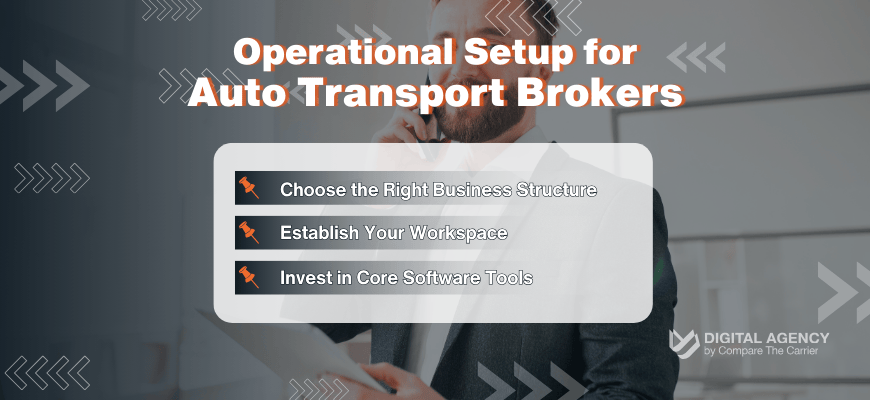
Choose Your Business Structure Wisely
How you structure your business impacts everything from taxes to personal liability. Common options include:
The best choice depends on your specific situation, risk tolerance, and growth plans. The U.S. Small Business Administration (SBA) offers a helpful guide to compare structures. Crucially, consult with a legal professional and a tax advisor to make the right decision for your circumstances.
Establish Your Workspace
Many brokers start successfully from home. Essentials include: A reliable computer, high-speed internet, a dedicated phone line (or VoIP), and a quiet workspace. Resources like PCMag offer comparisons of popular business VoIP providers.
Invest in Essential Software
Software is key for efficiency; managing quotes, carriers, and customers manually is unsustainable.
This setup is an investment in efficiency, scalability, and providing better service, allowing you to grow your business effectively.
Building a Reliable Network of Carriers
As an auto transport broker, you don’t own the trucks – you rely on carriers to physically move the vehicles. This makes your carrier network the absolute lifeblood of your business. Their quality and reliability are vital when starting an auto transport broker business, as poor service reflects badly on you and can damage your reputation.
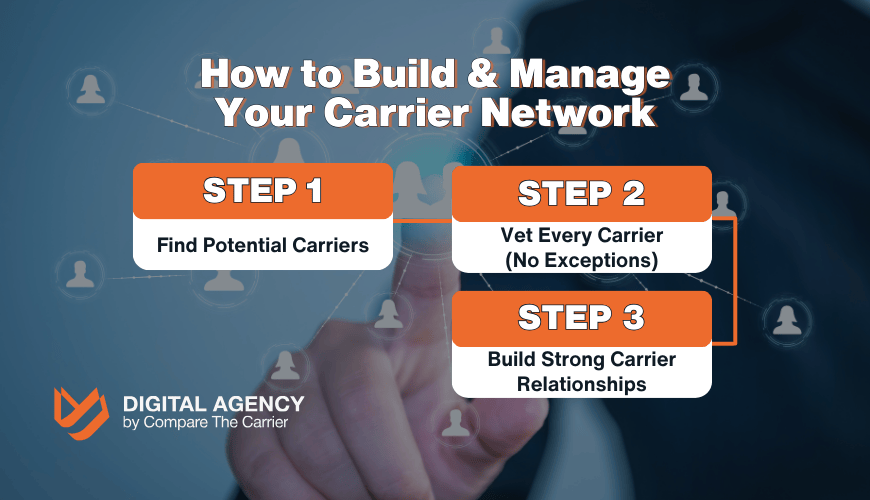
Finding Potential Carriers
Find carriers via auto transport load boards, TMS databases, and industry networking.
Vetting Carriers: The Non-Negotiable Step
Finding a carrier is easy; finding a good, reliable, and legal carrier requires due diligence. Never skip carrier vetting. Before entrusting a customer’s vehicle to a carrier, you MUST verify:
Your primary tool for these checks is the official FMCSA SAFER System. You can look up carriers by their USDOT or MC number to get a “Company Snapshot” with their authority status, insurance details (though always request a current Certificate of Insurance directly too), and safety rating information. Supplement this with online reviews or asking for references if possible, but the official FMCSA data is paramount.
Why is this critical? Using properly vetted carriers is fundamental to ensuring a secure over-the-road haul for your customers and protecting your brokerage from liability.
Building Strong Carrier Relationships
Finding and vetting is just the start. To build a reliable network, you need to foster strong relationships with good carriers. This makes you a broker they want to work for, which is invaluable when you need capacity. Keys to building loyalty include:
By consistently finding, vetting, and nurturing relationships with quality carriers, you build the operational backbone necessary to succeed and become a broker known for reliability and excellent service.
Implementing Effective Marketing and Sales Strategies to Attract Clients
You’ve done the legal legwork, set up your office, and know how to find carriers. Fantastic! But there’s one more giant piece to the puzzle when starting an auto transport broker business: getting paying customers (shippers). Without a steady stream of clients needing vehicles moved, your brokerage is just a well-organized hobby. Let’s dive into how you attract those crucial clients.
Build Your Online Foundation
In today’s world, your digital storefront is just as important as a physical one.
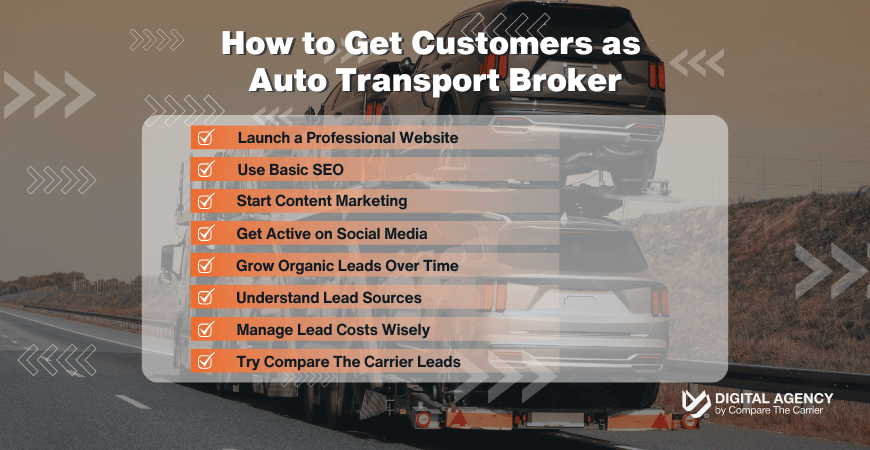
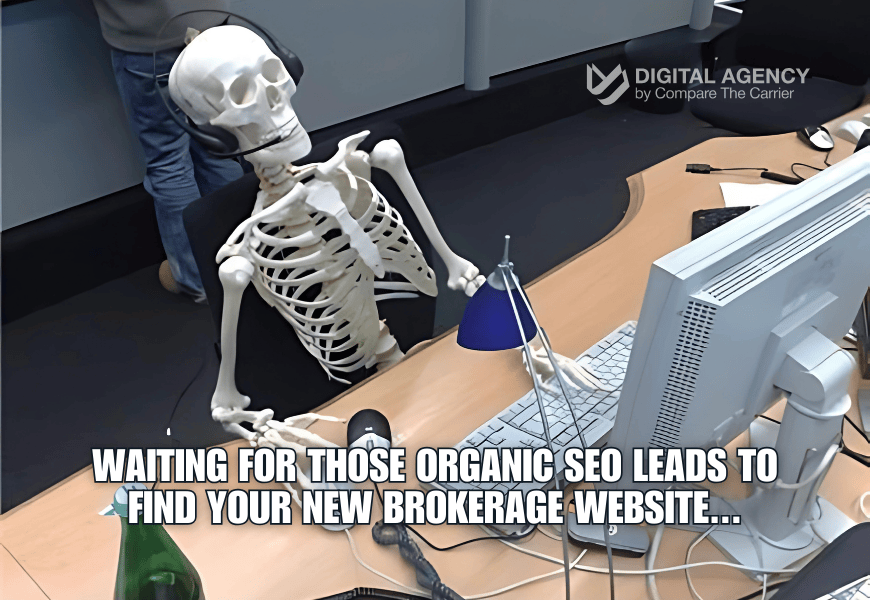
Developing and executing effective marketing and sales strategies takes time and expertise. If you’d rather focus on brokering deals, Compare The Carrier can provide marketing and development solutions tailored to US logistics companies, helping you attract clients and grow your business.
Ultimately, a multi-pronged approach – combining online presence, potentially buying leads, networking, and having a solid sales process – is usually the best way to become a broker with a healthy, growing client base.
How Compare The Carrier Can Accelerate Your Broker Business
Starting an auto transport broker business involves mastering many different areas, from legal requirements to carrier vetting and, crucially, finding customers. This is where Compare The Carrier can become a key partner in your success, providing targeted solutions to help you hit the ground running and grow faster.

Partnering with Compare The Carrier gives you access to tools and expertise specifically designed for the US auto transport industry, providing a significant advantage as you launch and scale your new brokerage.
Conclusion: Your Journey to Become a Broker Starts Now

Embarking on the path of starting an auto transport broker business is a significant undertaking, but as we’ve outlined, it’s a journey with clear milestones. From understanding the crucial role you play connecting shippers and carriers, conducting thorough market research, and meticulously navigating the legal maze of auto transport broker licensing, each step builds the foundation for your success.
Setting up the right infrastructure with essential tools like a TMS and CRM, diligently building a network of reliable, vetted carriers, and implementing smart marketing and sales strategies to attract clients are all vital components of a thriving brokerage. While the path requires dedication, attention to detail, and a commitment to excellent service, the potential within this dynamic industry is substantial.
You now have a roadmap. The steps are laid out, the challenges are identified, and the resources are available. Remember, success won’t happen overnight, but with careful planning, persistence, and a focus on building strong relationships with both customers and carriers, you can become a broker who not only survives but thrives. And as you navigate this journey, know that partners like Compare The Carrier are here to help accelerate your growth with targeted leads and expert agency support.
The road is open – your journey starts now!
FAQ
What’s the difference between an auto transport broker and a carrier?
Brokers connect shippers (customers) with carriers (trucking companies). Brokers don’t own the trucks; they act as intermediaries, arranging transportation using their network and expertise. Carriers physically own the trucks and perform the transportation.
How much does it cost to start an auto transport brokerage?
Startup costs vary. Key expenses include business registration fees, the FMCSA authority application fee (check current cost on the FMCSA fees page), the annual premium for the required $75,000 surety bond (this is typically a percentage of the bond amount based on your credit), BOC-3 process agent filing fees, essential software subscriptions (TMS, CRM), and potential marketing or lead generation costs.
Do I really need the $75,000 broker bond (BMC-84)?
Yes, absolutely. It’s a non-negotiable federal requirement mandated by the FMCSA for all licensed property brokers to protect shippers and carriers. You don’t need $75,000 in cash; instead, you purchase the bond from a surety company and pay an annual premium.
How long does it take to get FMCSA broker authority?
Processing times can fluctuate. After submitting your application through the FMCSA’s Unified Registration System (URS) and ensuring your bond (BMC-84) and process agent designation (BOC-3) are filed correctly, it typically takes several weeks for the authority to become active. It’s wise to check the FMCSA website for current estimates and start the process early.
What’s the best software for auto transport brokers?
Essential software includes a Transportation Management System (TMS) for managing quotes, dispatching, tracking, and carrier compliance (e.g., Central Dispatch, Super Dispatch). A Customer Relationship Management (CRM) system is also vital for managing leads and customer communication (e.g., HubSpot, Zoho CRM). Compare The Carrier offers guides on industry-specific options: Top Auto Transport CRMs and the Best Auto Transport Load Boards (which often overlap with TMS features)
How do I find reliable carriers?
You can find carriers using load boards (like Central Dispatch, DAT – see the Load Board Guide), TMS carrier databases, and industry networking. However, the most critical step is vetting. Always verify a carrier’s operating authority, insurance status, and safety record using the official FMCSA SAFER System before assigning them a load.
How do I find customers/shippers for my brokerage?
Attracting clients requires a multi-faceted approach. Build a professional online presence (website, SEO), engage in organic marketing like content creation and social media (Budget Lead Gen Guide, LinkedIn Guide), network with related businesses, and consider purchasing high-quality leads. Compare The Carrier provides auto transport leads to connect you with potential customers quickly. Remember to focus on lead quality (Zero Waste Leads info) and manage costs (Lead Cost Optimization info, Pay Less for Leads info).
Can Compare The Carrier help me get started or grow my broker business?
Yes! We offer targeted solutions for brokers. Our Vehicle Shipping Leads service can provide immediate customer opportunities. Additionally, if you need expert help with marketing, website development, or overall business strategy tailored to the US logistics market, our digital division is here to assist.




